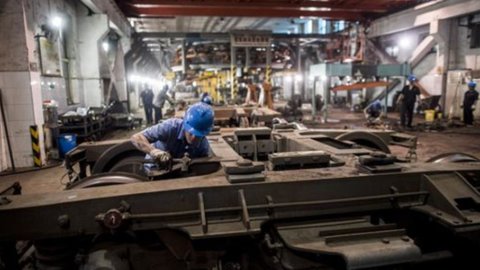In 2018, the European industry recorded a setback after the lively growth of 2017. Based on the data referring to the first ten months, and taking into account the relatively modest evolution foreseeable for the final part of last year, the major economies of the area would have gone from industrial production growth rates of between 3 and 4 per cent in 2017 to increases at best of just over 1 per cent in 2018.
Moreover, the positive change in European industrial production in the average annual figure is largely linked to the good statistical legacy transmitted from 2017 to 2018; in fact, looking at the profile of production, no growth was recorded during the year and, indeed, in the case of Germany the trend is even decreasing, especially in the second half of the year. This also means that the statistical legacy that 2018 will pass on to 2019 is very low, a year which, barring a sudden turnaround, will be characterized by a modest, if not negative, result for industrial production in the Eurozone.
In fact, the economic indicators show that the final part of 2018 and the beginning of 2019 were very weak; business confidence is still deteriorating; the expectations of manufacturing firms on the production trend and expectations on order books are worsening in most of the countries of the area. Similarly, data on the trend of employment in industry, which had also shown increasing trends up to 2017, also interrupted the growth phase; also the judgments of businesses on the evolution of employment levels in the coming months are experiencing a phase of weakening.
These are therefore signals that should not be underestimated. Although the current picture is in fact compatible with a stagnation of industrial activity, the risks of a recession phase have evidently increased over the last few months.
IN ITALY THE TRADITIONAL SECTORS HOLD DOWN
By disaggregating the production data according to the performance of the main sectors (details for the major Eurozone economies are shown in the tables included in the final pages), it emerges that the deceleration in 2018 was substantially shared by the major economies, and transversal to the various sectors of the industry. There are very few sectors that did better in 2018 than in 2017, and in several cases negative changes were already recorded in 2018.
The main trends can be summarized as follows.
First of all, 2018 was the year of slowdown in the auto cycle, which had contributed decisively to the growth of previous years. In part, this trend reflects, as mentioned, the specific problems of German industry; on the other hand, the slowdown began in 2017 and is shared by the major eurozone countries. This trend is in line with the hypothesis that in Europe demand has returned to levels consistent with the renewal of the stock of durable goods desired by households. The cycle of durables would therefore in fact be about to run out, as also highlighted, for example, by the turnaround in production in the furniture sector.
The structural trend of contraction in activity in the paper and publishing sectors continues, due to the crowding out of the new online information channels.
Pronounced contractions characterized textiles and clothing, falling in the major countries with the exception of Italy in 2018. For clothing, the significant increases that characterized production in Spain during the previous years should be noted. In Italy we note the very positive trend of the leather industry.
Among other non-durables, the food industry sector remained on a path of slight expansion; note the loss of positions of the food industry in France and the particularly positive performance of the beverage industry in Italy. Production growth in the machinery sectors remained buoyant, albeit lower than in previous years. The growth is also mainly linked to the good statistical legacy received from 2018. In fact, the profile observed during 2018 is relatively flat. A similar argument also applies to electronic products.
Pharmaceuticals are among the sectors experiencing sustained growth. In this case, the trend is shared by all countries, reflecting a structural acceleration in demand, partly linked to product innovations as well as factors linked to demographics.
ITALIAN INDUSTRY CLOSES THE GAP COMPARED TO OTHER EURO AREA COUNTRIES
Focusing attention on the relative performance of Italian industry compared to other countries in the euro area, it can be seen that in recent years this has performed better in the sectors producing traditional consumer goods. Especially food, beverages, leather goods and furniture. Beyond the slowdown in 2018, these sectors are holding up in international comparison, achieving growth rates equal to or higher than those of other European economies. This is an important result above all in the light of the fact that consumption in Italy is growing at decidedly lower rates than in other countries, which should penalize the consumer goods-producing sectors to a greater extent.
On the other hand, considering the aggregate performance of Italian industry more generally, it should be emphasized that in 2018 we confirmed a trend in line with that of the other economies of the Eurozone, as already observed in the previous two years.
Italian industry has therefore been demonstrating for some years now that it is able to keep up with the European one, a result that constitutes a marked improvement compared to the trends of the years prior to 2016, when our industry was systematically losing ground. -reno compared to the other major economies, and to Germany in particular.
The closing of the gap is also confirmed by the trend of the added value of industry.
The importance of this result is evident if one recalls how Italian industry in the XNUMXs accumulated a very wide growth gap compared to the other economies of the euro area. This evidence had prompted us to embrace, among the various interpretative hypotheses, the theme of the loss of competitiveness of sectors exposed to international competition, and therefore of the problems deriving from the loss of flexibility of the exchange rate, understood as a necessary tool for rebalancing our competitive position.
The realignment of Italian industry to the rhythms of the other eurozone countries could instead be a sign of the fact that the system has adjusted its relative competitive position vis-à-vis the other economies of the eurozone. On this aspect, it should be emphasized that especially since 2018 there has been a widening in the growth differentials of the ULC between the countries of the euro area: the most significant aspect is represented by the wage acceleration underway in Germany, in line with the better conditions of the German labor market compared to other euro area economies. Contract renewals are in fact bringing the dynamics of German wages close to 4 per cent, against a still very weak trend in other countries, above all Italy.
Italian industry is therefore gradually realigning itself with the rest of the euro area, also thanks to the recovery of competitiveness determined by the low wage growth compared to Germany. This is an evidently still inadequate trend for definitively relaunching our economy; in fact, lower wage dynamics correspond to gains in competitiveness, but also downward pressure on the levels of domestic demand. It is no coincidence that while industry keeps pace with other countries, other sectors, which do not directly benefit from foreign demand, maintain significant growth gaps.
On the other hand, the stability of Italian industry in international comparison is one of the few positive notes in a panorama that presents itself full of difficulties. Despite all its limitations, the Italian growth model remains based on industry and on the ability of our traditional sectors to control important parts of the global markets. It's not enough, but for now it's what we have.





